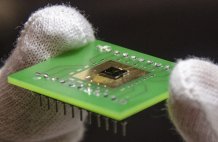Articles

“Extraordinary linear dynamic range in laser-defined functionalized graphene photodetectors”, is published in Science Advances
New technique could revolutionise manufacturing of vital safety equipment
An innovative new technique to use graphene to produce the ultimate photodetectors could revolutionise the manufacturing of vital safety equipment, such as radiation and smoke detection units.
An international research team, led by experts from the University of Exeter, has pioneered a new method that could pave the way for a new frontier in high-definition sensors.
Although graphene has been used before in photodetectors – an electronic component that detects the presence of visible light, infrared transmissions or ultraviolet energy – they are limited by how well they respond to light.
In this new study, the team has created a new type of photodetector that can sense light around 4500 times better than traditional graphene sensors. The discovery could herald a new generation of sensoring and imaging equipment that is more stable in harsh conditions, as well as been smaller and most cost-effective.
The study was published in leading journal, Science Advances, on Friday May 26 2017.
Dr Adolfo De Sanctis, lead author of the study and from the University of Exeter said: “This discovery has the potential to enable us to make very small, very thin and inexpensive sensors that can be used in by agencies and households across the world.
“It opens up a new frontier of just what these graphene photodetectors can achieve, and bring a new golden age of imaging and sensing technologies.”
Photodetectors are predominantly used to convert light signals that hit a junction to a voltage or current, into electricity. This junction has now been defined by moving individual molecules sandwiched between layers of graphene.
Professor Saverio Russo, co-author of the paper and also from the University of Exeter added: “In this work we demonstrate that dressing the structure of graphene with molecules can transform the optical and electrical response of this wonder material and enable unprecedented applications.”
“Extraordinary linear dynamic range in laser-defined functionalized graphene photodetectors”, is published in Science Advances.
Date: 19 June 2017
